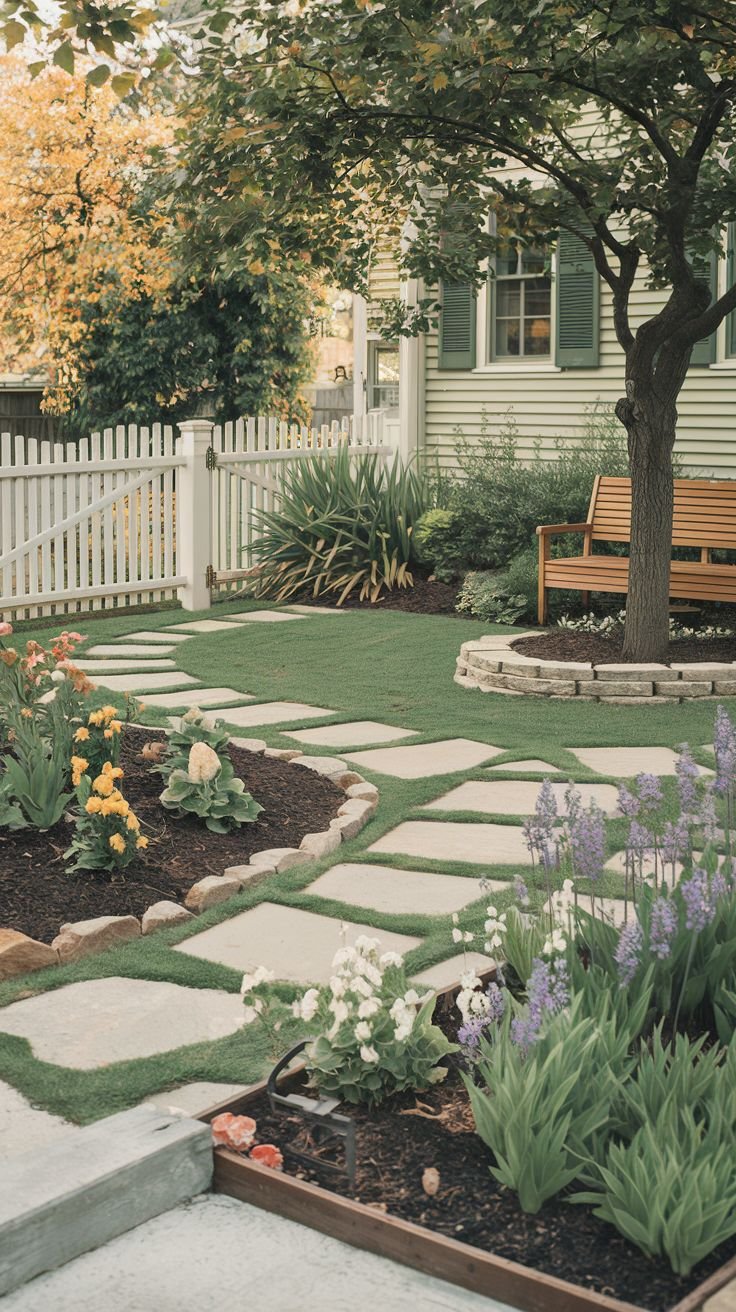26 Simple & Low Maintenance Front Yard Landscaping Designs for a Comfortable Feel
Creating an inviting yet manageable front yard is a common goal for homeowners.
This article explores 26 distinct landscaping designs that prioritize simplicity and minimal upkeep.
Each design offers practical solutions, focusing on elements like pathways, planting choices, and structural features, all aimed at reducing the time and effort typically associated with garden maintenance.
From clever uses of gravel and pavers to strategic plant selections, these ideas demonstrate how to achieve an attractive front yard without demanding constant attention.
1. Create a Stepping Stone Path through Gravel and Lawn

Lay large, rectangular stepping stones directly onto a base of gravel to form a straightforward pathway. Surround the path with areas of low-growing ground cover or simple gravel, contrasted with a well-maintained lawn. Plant small, hardy shrubs and perennial flowers along the edges of the gravel or lawn for minimal upkeep. Install a simple picket fence for a classic, low-maintenance boundary. Place large accent boulders in the lawn area to add visual interest with no maintenance required.
2. Design a Modern Path with Gravel and Boulders

Install a path using long, wide rectangular pavers with small gaps between them. Fill the spaces between and around the pavers with small grey gravel for easy drainage and weed control. Border the gravel area with varying sizes of natural river stones. Incorporate low-lying bushes or small trees that require minimal pruning. Add features like a simple white gate and a pergola structure with hanging lanterns for aesthetic appeal that needs occasional cleaning rather than complex plant care.
3. Incorporate Large Format Pavers with Minimal Plantings
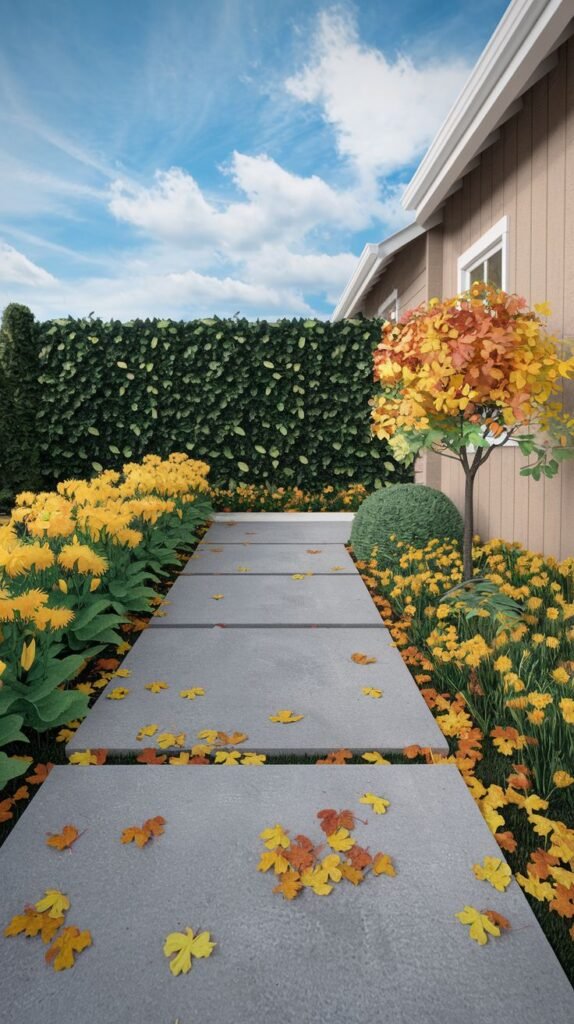
Use extra-large rectangular concrete pavers to create a dominant pathway. Keep the areas around the path simple by using minimal ground cover or allowing fallen leaves to provide natural mulch. Plant rows of vibrant, low-lying flowers along the path’s edge that bloom generously with minimal intervention. Include a single, striking ornamental tree with seasonal color near the house. Define the yard boundary with a dense, tall hedge that only requires occasional trimming.
4. Build Tiered Planters with Brick and Stone Paths
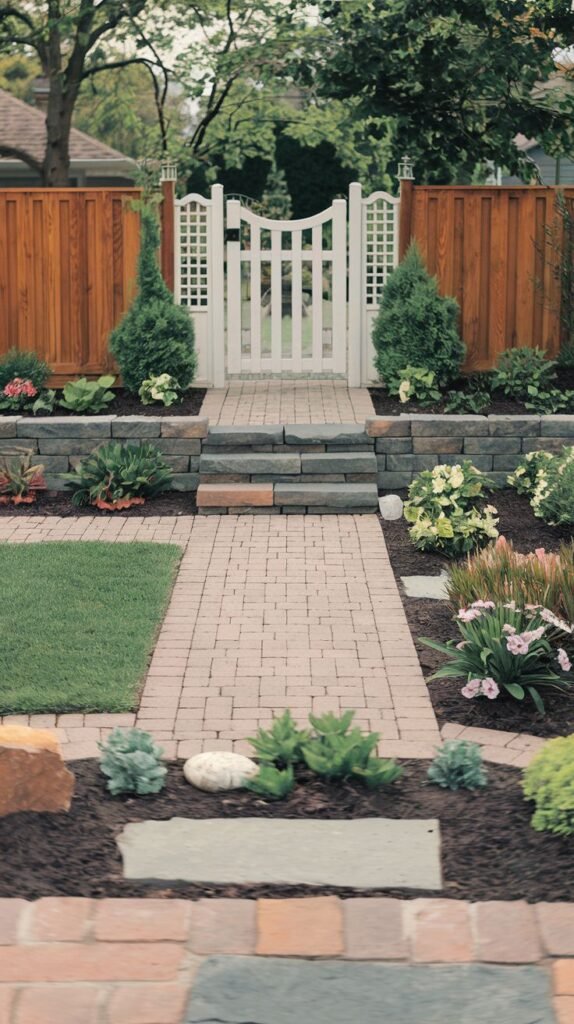
Construct raised garden beds using stacked stones or bricks to simplify planting and reduce bending for maintenance. Create a main pathway using small rectangular pavers laid in a repeating pattern. Introduce sections of the path using natural stone slabs for varied texture. Plant compact, evergreen shrubs and perennial flowers in the raised beds that return each year with little fuss. Install a decorative white gate within a wooden fence for a charming and low-maintenance barrier.
5. Lay a Gentle Curve of Gravel with Lavender Borders

Shape a gently curving pathway using fine grey gravel. Define the edges of the gravel path with a simple metal border to keep gravel contained. Plant swathes of fragrant lavender along both sides of the path, known for its drought tolerance once established. Incorporate neatly trimmed evergreen bushes for structure that requires infrequent pruning. Include a distinctive small tree like a Japanese maple as a focal point that needs minimal care beyond occasional shaping.
6. Combine Gravel Paths with Structured Plantings and Pavers
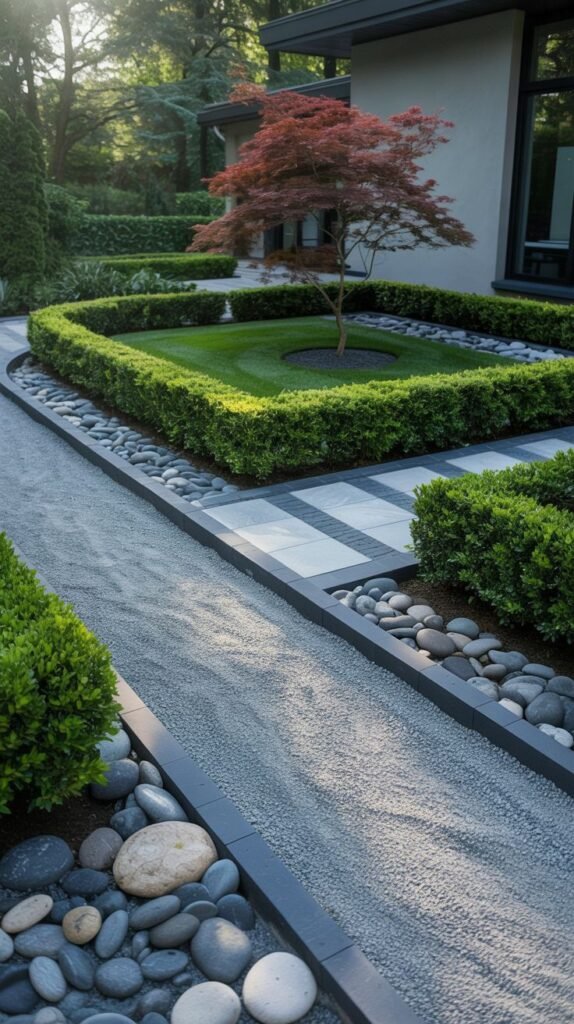
Utilize light-colored gravel for broad pathway areas, providing excellent drainage. Edge the gravel with dark, structured borders for a clean look. Incorporate sections of the design using rectangular pavers laid with thin gaps filled with gravel. Plant low, dense evergreen hedges to create defined shapes and borders, requiring only seasonal trimming. Scatter large, smooth river stones within the gravel areas and along borders for visual interest and no maintenance. Maintain a small, central patch of lawn enclosed by hedging.
7. Design Curved Gravel Beds with Spherical Bushes
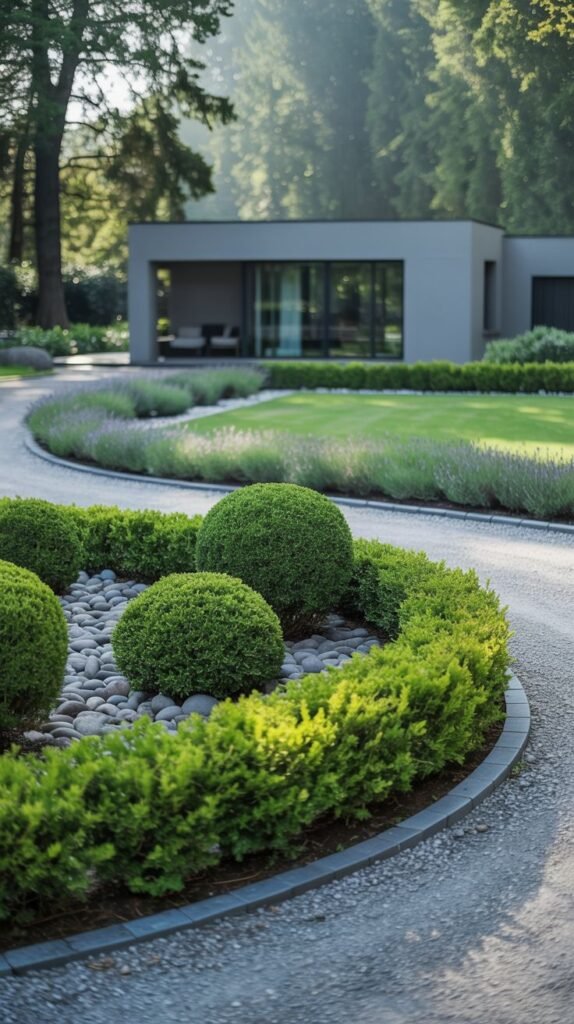
Create sweeping, curved beds filled with light-colored gravel. Edge the beds with a dark, clean border. Plant clusters of perfectly spherical evergreen bushes within the gravel beds, providing a sculptural element that only needs occasional shaping. Incorporate smooth, varied river stones among the bushes and gravel for texture and visual appeal. Use lavender or similar hardy, low-maintenance flowering plants along larger curved borders.
8. Install Stone Stepping Stones in a Grassy Area
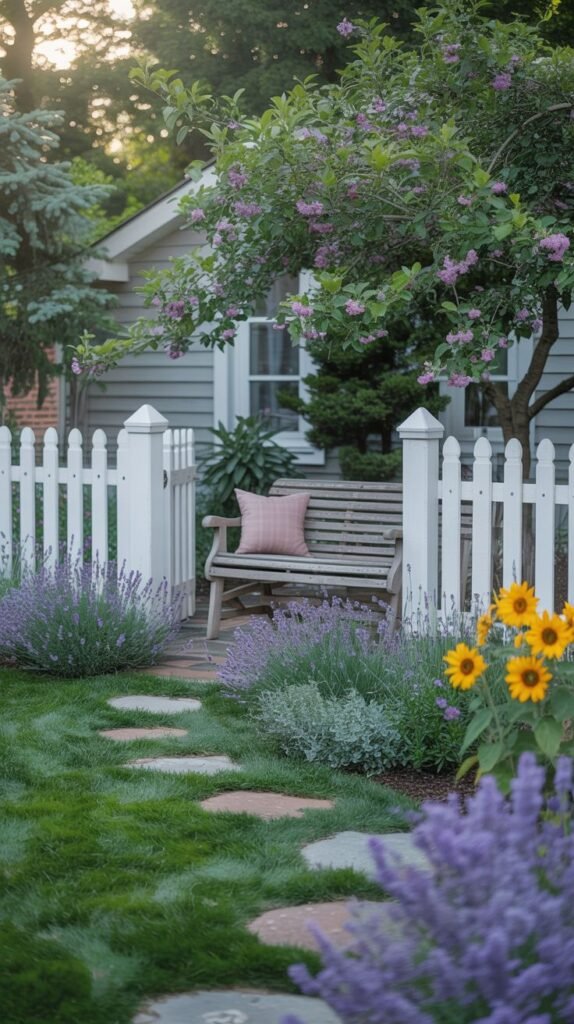
Set irregularly shaped stone stepping stones directly into a well-kept lawn. This reduces the amount of paved surface while providing a clear path. Edge the lawn and stepping stones with hardy, flowering perennials like lavender and sunflowers that are relatively self-sufficient once established. Place a simple wooden bench near the path for a resting spot. Install a classic white picket fence as a low-maintenance property line marker.
9. Create a Cobblestone Courtyard with a Central Planter

Lay a patterned courtyard using small, light-colored cobblestones for a durable and timeless surface. Design a central, raised planter bed using stone blocks. Edge the courtyard area with neatly trimmed boxwood hedges for evergreen structure. Fill the central planter and surrounding beds with a mix of colorful annuals and hardy perennials, choosing varieties known for continuous blooming with minimal deadheading. Incorporate climbing roses trained up the house walls for vertical interest that requires only yearly pruning.
10. Line a Stepping Stone Path with River Stones and Colorful Flowers

Construct a straightforward path using large, rectangular stepping stones. Border the stepping stones with a line of smooth river stones before the planting beds begin. Plant rows of vibrant, colorful flowers like tulips, daffodils, and peonies along both sides of the path, choosing bulbs and perennials that require minimal seasonal care. Use dark mulch in the planting beds to suppress weeds and retain moisture. Define the yard boundary with a simple wooden fence.
11. Place Concrete Pavers Amidst Gravel and Boulders
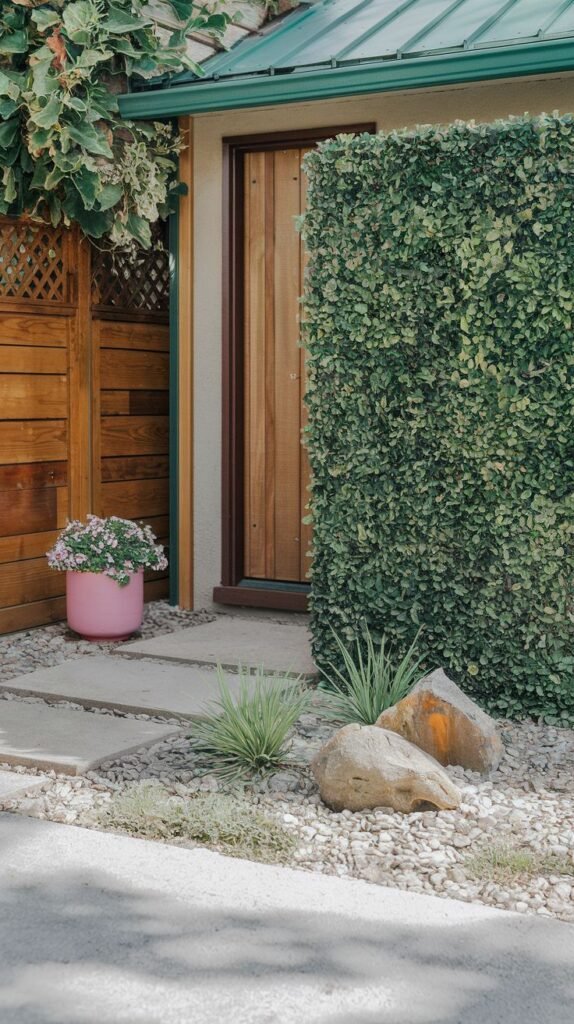
Set rectangular concrete pavers to create a small landing or short path segment near the entrance. Surround the paved area with light-colored gravel. Introduce small, hardy succulent-like plants and medium-sized natural boulders within the gravel beds for a xeriscape-inspired, low-water design. Use a dense, upright hedge to screen areas and provide a green backdrop.
12. Lay Large Concrete Stepping Stones for an Easy Path
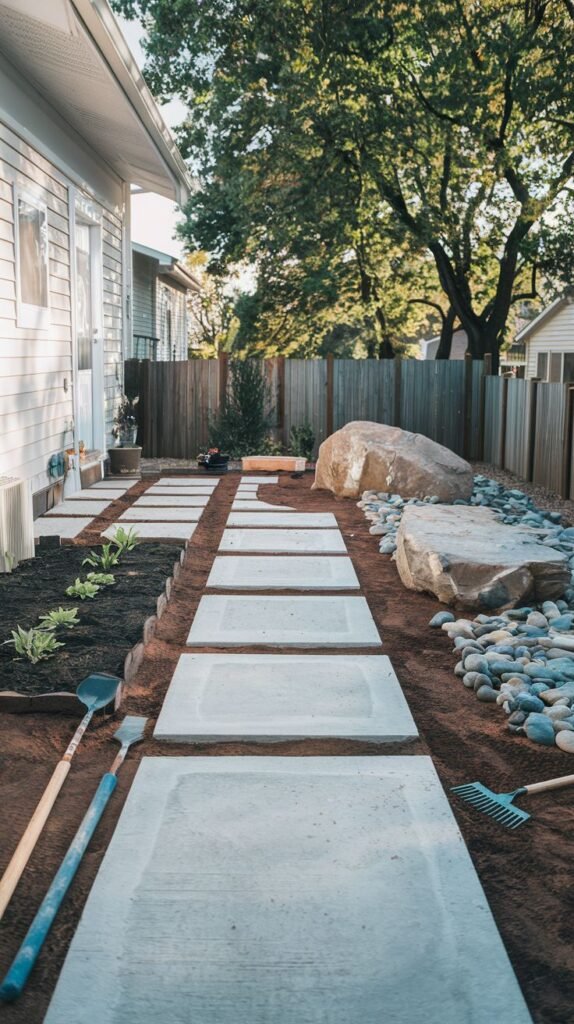
Install very large, rectangular concrete stepping stones with wide gaps for a simple, modern pathway. Fill the spaces between the stones and surrounding areas with compacted earth or small gravel. Line the path with newly planted ground cover or low shrubs that will fill in over time. Incorporate one or more large accent boulders near the path for visual weight and zero maintenance.
13. Combine Stepping Stones with Mulched Beds and Flowers
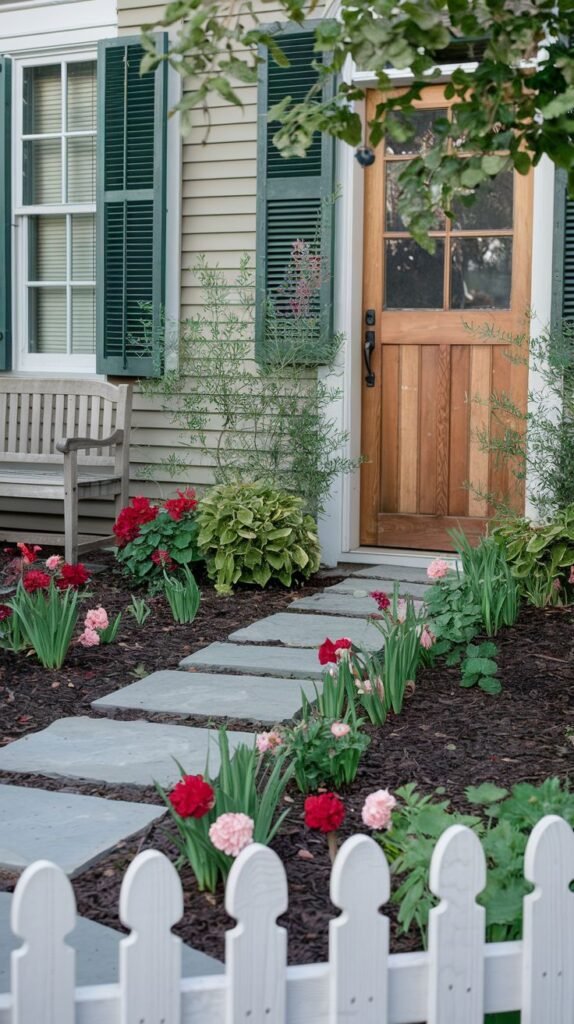
Lay simple stepping stones to form a direct path to the entrance. Fill the areas around the path with dark-colored mulch to reduce weeds and retain moisture. Plant hardy, colorful perennial flowers like carnations and hostas along the edges of the path and mulch beds for continuous bloom with minimal deadheading. Use a small, decorative white picket fence as a charming border that requires only occasional painting.
14. Create a Water Feature with Stepping Stones and Gravel
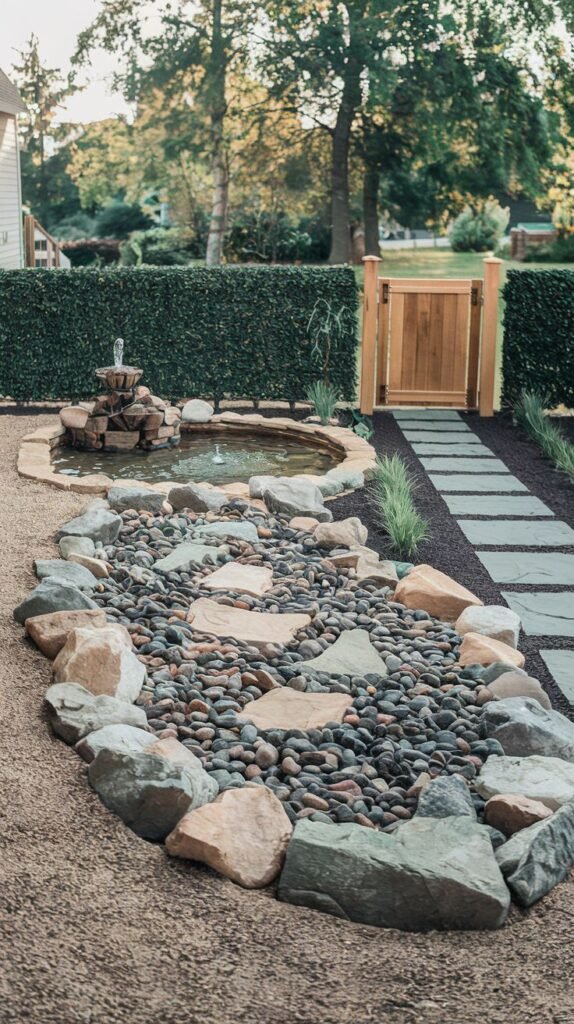
Design a central water feature with circulating water to add a calming element with minimal maintenance. Border the water feature with large, natural stones of various sizes. Create stepping stone paths using irregularly shaped stones across sections of dark river stones and light gravel. Use a dense, tall hedge as a backdrop for privacy and simple structure. Install a simple wooden gate to provide access through the hedge. Lay rectangular concrete pavers for another path segment leading away from the main feature.
15. Incorporate Topiary and Ornamental Grasses Around Stepping Stones

Lay rectangular stepping stones in a straight line or gentle curve through sections of lawn and gravel. Plant sculptural topiary plants along the pathway or near features like a gate, requiring only infrequent trimming to maintain their shape. Add tall, wispy ornamental grasses for texture and movement that are often drought-tolerant and need minimal attention. Include a large accent boulder within the gravel or planting beds. Use a solid fence and a simple wooden gate as a low-maintenance boundary.
16. Design Raised Planter Boxes with Stepping Stones and Gravel

Construct raised planter boxes using a durable material like wood or composite to simplify planting and weed control. Fill the boxes with a mix of hardy annuals and perennials like tulips, daffodils, and pansies that provide seasonal color. Lay rectangular stepping stones amidst light-colored gravel to create a pathway leading past the planters. This combination reduces lawn area and subsequent mowing.
17. Lay a Curved Paver Path with Mulched Beds and Flowers

Install a curved pathway using small rectangular pavers edged with a darker stone border for definition. Create sweeping planting beds alongside the path filled with dark mulch to suppress weeds. Plant groups of colorful, low-growing perennial flowers that provide bursts of color with minimal deadheading. Define the property line with a stone wall that requires no maintenance. Include a decorative wooden gate within the stone wall.
18. Utilize Curved Gravel Paths with Stone Features and Mossy Boulders
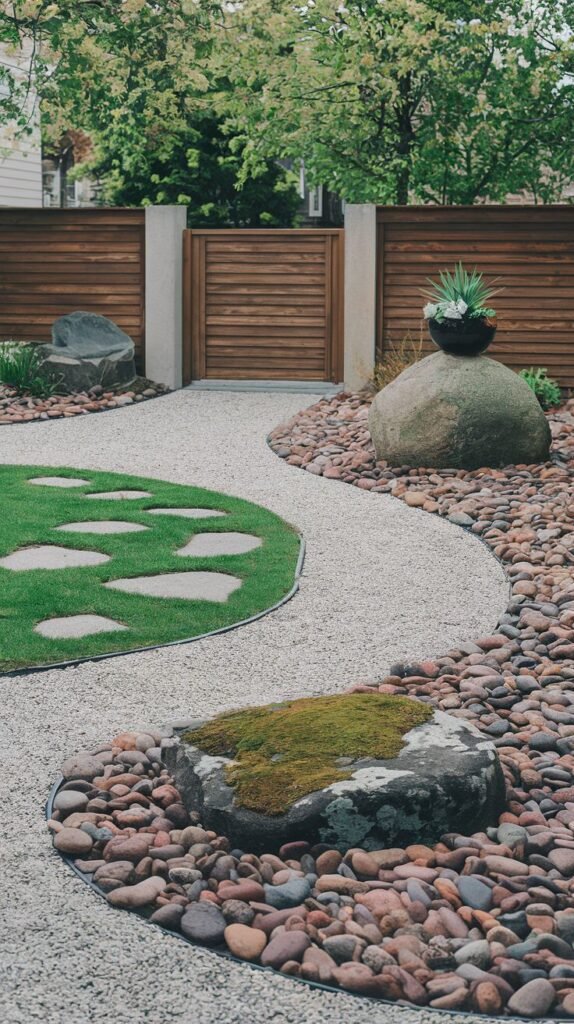
Shape gently curving paths using light-colored gravel. Edge the gravel paths with a dark, flexible border. Introduce areas of river stones of varying sizes and colors alongside the gravel paths. Place large, distinctive boulders, some covered with moss, as focal points within the gravel or stone areas. Incorporate irregularly shaped stepping stones set within patches of lawn to create alternative routes. Use a horizontal slatted fence as a modern and low-maintenance boundary.
19. Create a Brick-Edged Paver Path with Structured Planting Beds

Lay a pathway using rectangular pavers in a repeating pattern. Edge the pathway with stacked bricks to create a clean, structured border. Design small planting beds bordered by the bricks, filling them with dark stones and low-maintenance plants like hostas and ground covers. Include small topiary trees in defined planting areas for a formal element that requires minimal shaping. Use artificial turf for lawn areas to eliminate mowing.
20. Design a Winding Stepping Stone Path through Gravel and Mulch
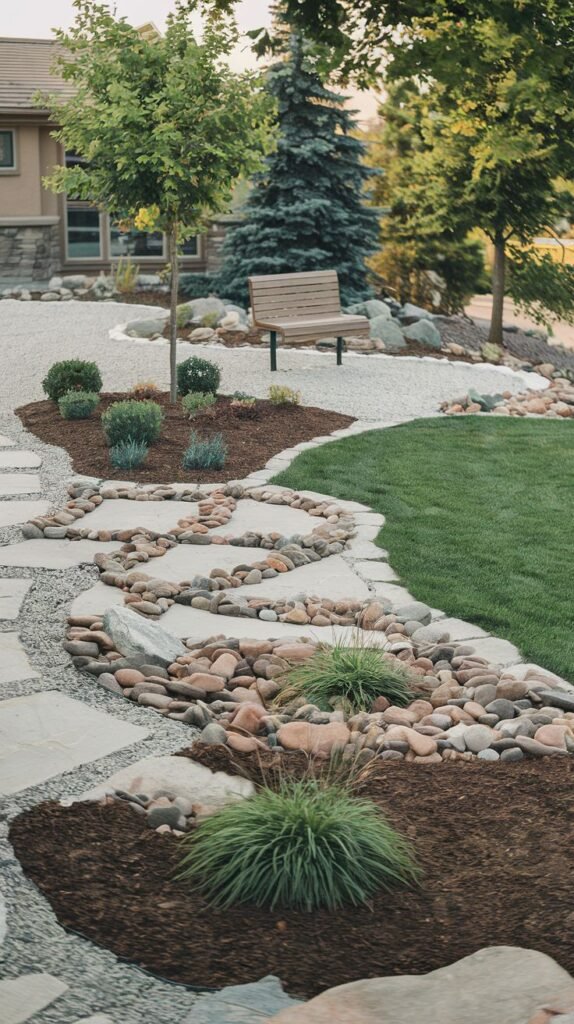
Install a winding path using irregularly shaped stepping stones. Surround the stepping stones with a mix of light-colored gravel and areas of dark mulch. Incorporate large clusters of river stones along the edges of the path and within the gravel beds. Plant hardy ornamental grasses and small, drought-tolerant shrubs in the mulched areas. Place a simple wooden bench in a gravel area for a resting spot.
21. Install a Stepping Stone Path with Mulched Beds and Mixed Flowers
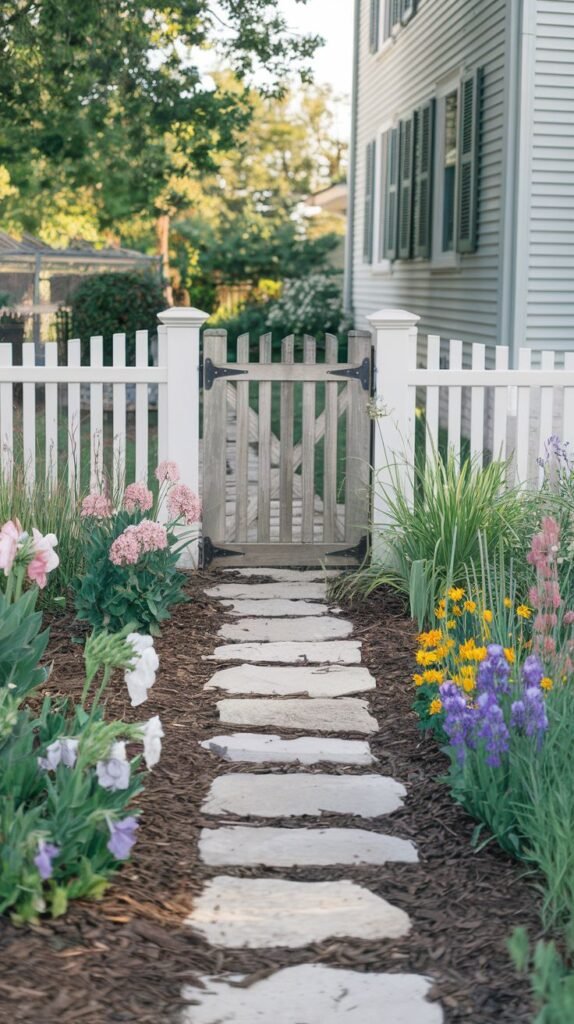
Lay irregularly shaped stepping stones to create a pathway leading to the entrance. Fill the areas around the path and the main beds with dark mulch. Plant a variety of colorful perennial flowers and grasses in the mulched beds, selecting species known for their resilience and minimal need for deadheading or pruning. Use a classic white picket fence as a simple boundary and a wooden gate for access.
22. Create a Curved Stepping Stone Path Integrated with Lawn
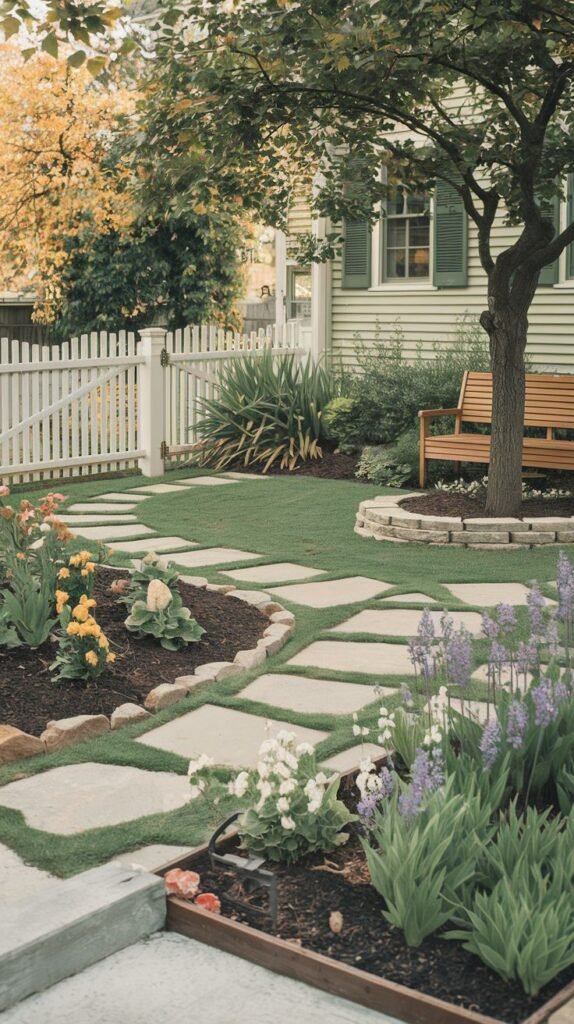
Set irregularly shaped stepping stones in a curved pattern directly into the lawn. This minimizes the amount of hardscaping and retains green space. Edge the lawn and stepping stone area with mulched planting beds. Fill the beds with a mix of hardy flowers, shrubs, and ground covers that are low maintenance once established. Include a simple wooden bench under a tree for a focal point. Use a white picket fence for a classic, low-maintenance boundary.
23. Design a Modern Entry with Stepping Stones and Planters

Lay large rectangular stepping stones with small gaps filled with small grey stones to create a clean, modern pathway. Place large, modern rectangular planters near the entrance. Fill the planters with low-maintenance, upright plants like ornamental grasses or succulents that require infrequent watering and pruning. Plant additional hardy, low-growing plants in the small beds alongside the stepping stones.
24. Utilize Large Concrete Pavers with Gravel and Raised Planter
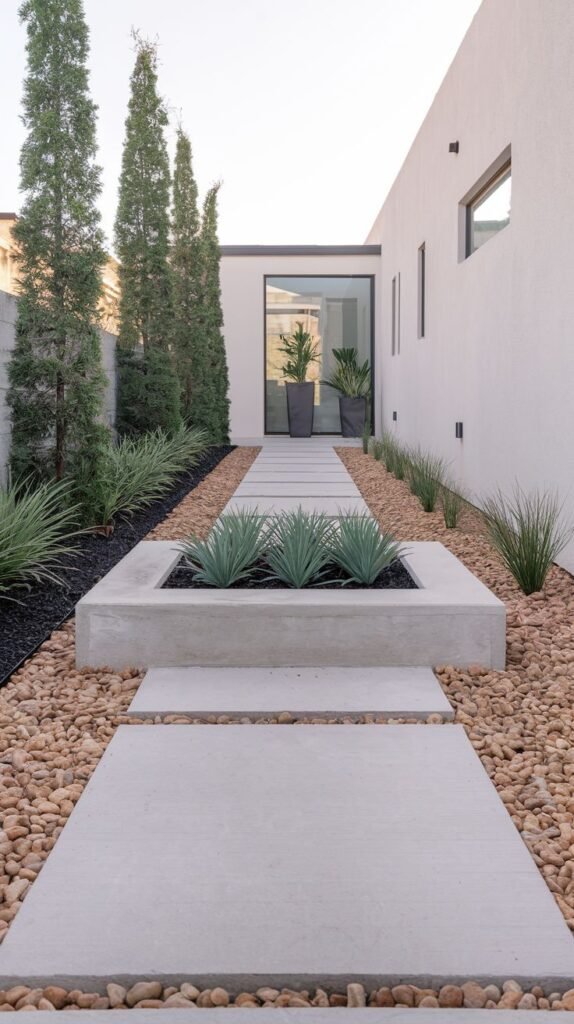
Install very large rectangular concrete pavers to create a spacious, minimalist pathway. Surround the pavers with light-colored gravel. Construct a raised rectangular planter using concrete blocks within the gravel area. Fill the planter with low-water, architectural plants like agaves or similar succulents. Plant tall, narrow evergreen trees along a wall for vertical screening that requires minimal trimming. Use dark mulch in other planting beds for weed suppression.
25. Place Large Concrete Pavers Amidst Grey River Stones and a Square Planter
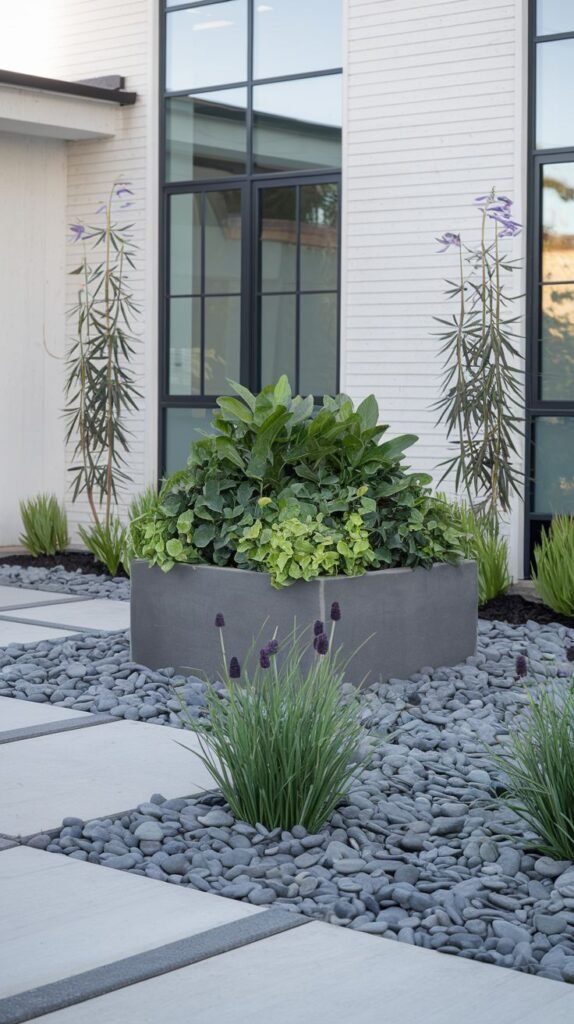
Lay large rectangular concrete pavers with thin gaps to form a modern pathway. Fill the areas between the pavers and around the path with smooth, grey river stones. Place a large, square modern planter filled with a mix of low-maintenance plants including hostas and ornamental grasses within the stone area. Include additional hardy plants like lavender or similar flowering perennials among the stones.
26. Border a Paver Path with a Dense, Low Hedge
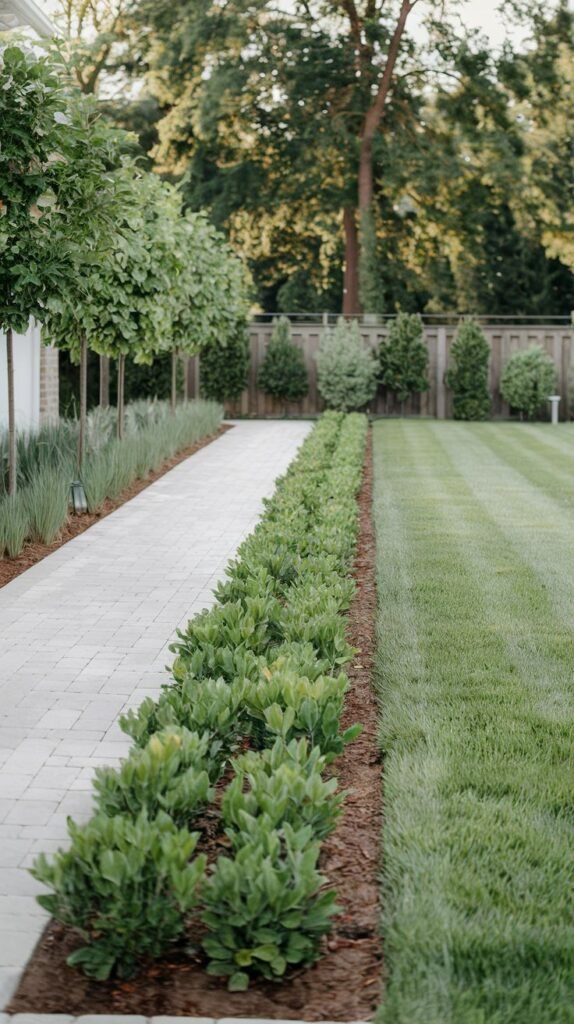
Install a pathway using rectangular pavers laid in a pattern. Edge the path with a dense, low-growing evergreen hedge that creates a formal, clean line. Maintain a neatly mown lawn adjacent to the hedge. Plant structured trees along a fence line to provide a green backdrop that needs only occasional pruning. Use dark mulch in the hedge beds to suppress weeds.
